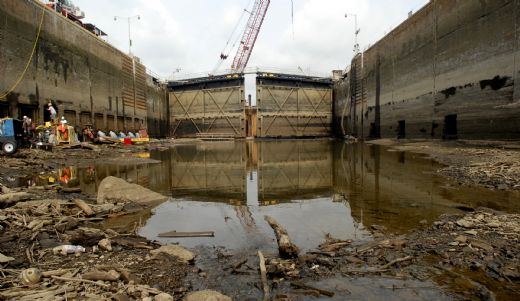Failing Locks Jam River Traffic
Pittsburgh Tribune-Review
15 May 2010
By Tim Puko

Crews work on the 16 emptying valves in the
dewatered main lock chamber of the Emsworth Lock and Dam on the Ohio
River, Friday, May 14th, 2010, as renovation of the 80-year-old
navigation structure continue
Waiting for a half-hour outside the Fort Pitt Tunnel barely compares to
what Herman Murphy went through in the past two weeks.
His towboat, the Connie K., was stuck in a 24-hour traffic jam on the
Ohio River on Friday, a week after he spent 48 hours stuck in the same
area near Neville Island, he said. Instead of delivering five barges of
coal, he and his crew did some spring cleaning on the boat, cut rope
and watched a lot of television.
"You go a little stir-crazy," said Murphy, 52, a 23-year veteran pilot
with Campbell Transportation Co., based in Dunlevy, Washington County.
"And the guys at these (businesses that take our coal), they don't get
to work either; they just sit at home. That's why it's essential to get
this commerce moving up and down the river."
To do that effectively could take more than $2 billion, according to
the Army Corps of Engineers.
The government needs to completely replace the chronically failing
locks that channel boats around three dams on the Ohio River northwest
of Pittsburgh, according to preliminary study recommendations from the
corps. Construction would take six to eight years, but it likely would
be more than two decades before that work finishes, project manager
Kevin Logan said.
Cash will be a problem, officials said. Regular funding for the corps
has dwindled, and it needs $1 billion to fix similar problems on the
Monongahela River's locks and dams.
To save money, corps officials recommend new locks only 600 feet long,
matching their current length. The rest of the locks on the Ohio are
twice as long, and that's what local shippers want, said Mary Ann
Bucci, assistant executive director of the Port of Pittsburgh
Commission.
The Connie K., for example, is a common length with a barge train 1,000
feet long, Murphy said. It would need to separate to pass through a
600-foot lock. That would double what should be an hour-long passage,
creating a backup for boats behind it.
"It's like driving on a multilane highway, and then it all turns into
one single lane for no reason at all," Bucci said. "Why would you keep
all (the Ohio River) infrastructure the same? ... If 600 (feet) is
antiquated now, what's it going to be like when this project is
actually completed?"
Tim Puko can be reached at tpuko@tribweb.com or 412-320-7991.
